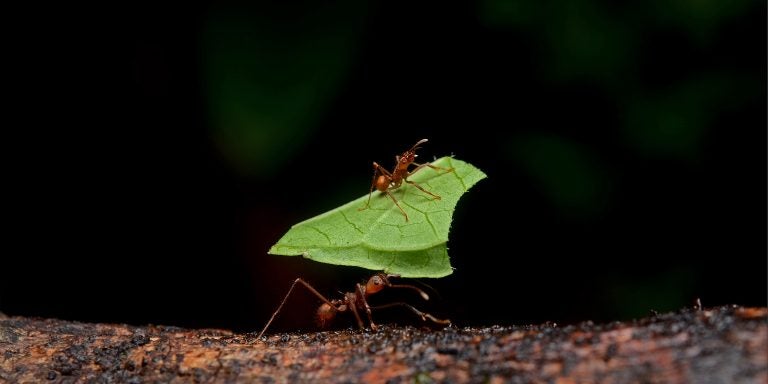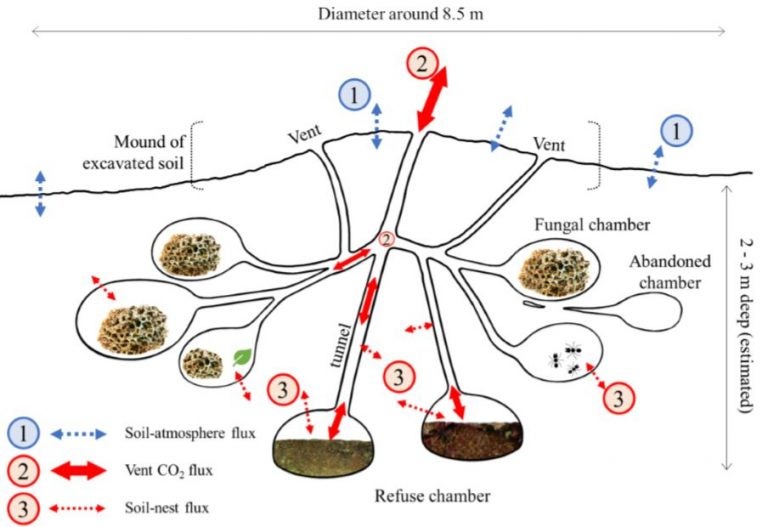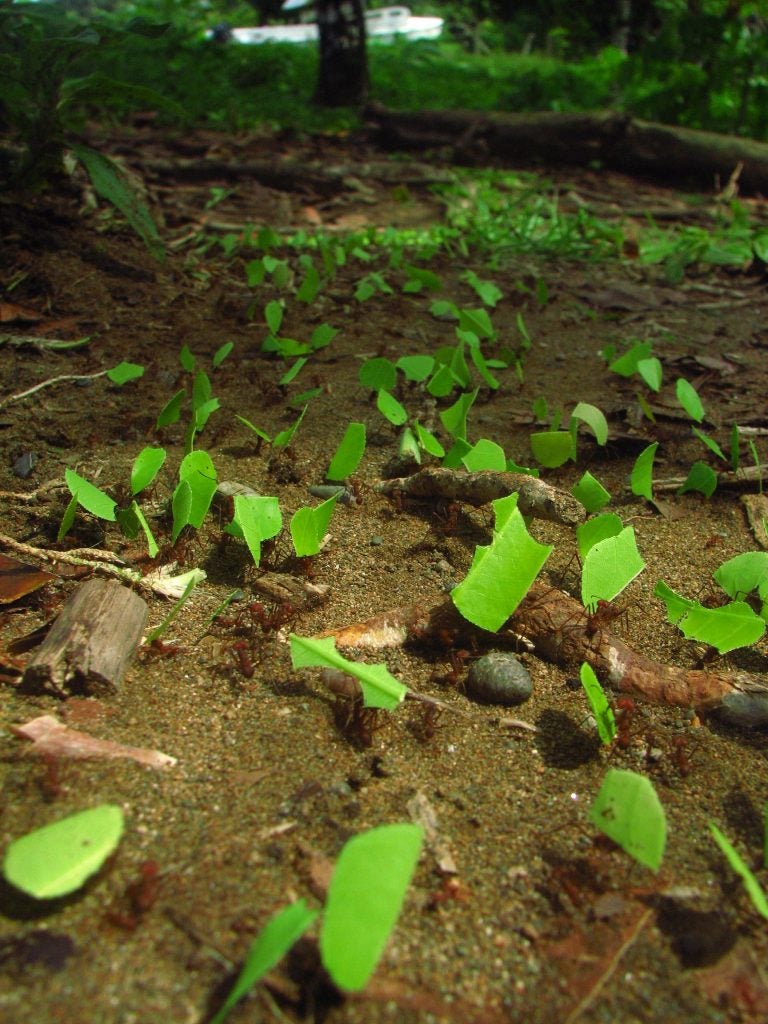Factories mass produce goods for society and many emit greenhouse gases in the process, but not all are run by humans. Some factories lie underground and are operated around the clock by tireless six-legged workers.
A new study in the Journal of Geophysical Research: Biogeosciences, a journal of the American Geophysical Union, shows leafcutter ant nests can emit carbon dioxide at a rate thousands of times higher than regular soil. The amount of carbon dioxide vented to the atmosphere is small compared to other emission sources, but the environmental impact of these nests could increase as warming temperatures and human development continue to extend the boundary of ant-habitable land, according to the study’s authors.
Leafcutter ants seen at La Selva Biological Station, Heredia, Costa Rica Credit: Geoff Gallice, CC-BY-2.0
Atta cephalotes, the species of leafcutter ant examined in the new study, are, like humans, ecosystem engineers. These ants alter their environments by building large complex networks of underground tunnels and chambers. The huge ant colonies sometimes extend as far as 7 meters (23 feet) underground. They house millions of ants and can remain inhabited for more than a decade.
The ants dice up leaves, as their name suggests, and haul them back home to cultivate fungi. The fungi decompose the leaves and produces ant food in return. The fungus farming activity makes the nests hot spots for carbon dioxide production, according to the authors of the new study. Ant and fungal metabolism, along with the vegetative decomposition, contribute to the generation of gas underground, which is eventually vented to the atmosphere.
“You can kind of envision them as little factories in the jungle,” said Thomas Harmon, a Professor in the School of Engineering at the University of California Merced in Merced, California, and co-author of the new study.
Diagram of carbon dioxide exchange and transport pathways in leafcutter (Atta cephalotes) nests Credit: JGR- Biogeosciences/AGU
Nature’s carbon emitters
Soil is one of the largest carbon stores on the planet. The activity of roots and microbes in the ground causes carbon dioxide to accumulate and eventually release into the atmosphere. Scientists often measure soil carbon emissions to better project changes in the climate, but some features of soil, like ant nests, are not currently considered.
In the new study, the researchers, assisted by the Organization for Tropical Studies, examined carbon dioxide in ant nests and surrounding soil in a Costa Rican rainforest. They directly measured carbon emissions from soil and from the chimney-like gas vents at the top of the nests.
The vents themselves emit much more carbon dioxide than the soil, the researchers found. Measurements of gas flowing out of individual vents showed carbon dioxide emissions were 10,000 to 100,000 times greater than values measured from soil, although the vent emissions only represent a small fraction of total emissions from the rainforest.
“The vents coming out of the nest were really remarkable,” Harmon said. “the first time we saw [measurements] we were like ‘wow’.”
A greater impact
Traditional methods of measuring soil carbon emissions would typically overlook natural contributions from ant nests, but this blind spot could cause scientists to miss out on important emission sources, according to the study authors.
“If you measure the soil by the traditional way, you are missing hot spots that may be a significant part of the real emissions” said Angel Fernandez-Bou, an environmental engineering Ph.D. student at the University of California Merced and lead author of the new study.
Other organisms may also emit similar amounts of carbon dioxide to the atmosphere and not accounting for these potentially large contributions could be underestimating soil carbon emissions, Fernandez-Bou said.
Leafcutter ants transporting leaves Credit: Bandwagonman at English Wikipedia
Flourishing in a changing world
The ecological impact of these natural sources of carbon emissions could become more pressing in the future as human development expands the ants’ habitat, according to the authors.
Provided the option, leafcutter ants prefer to establish their homes close to human infrastructure and establishments, Harmon said. Roads conveniently remove natural obstacles for the ants, making it easier to forage for resources, and plantations provide the ants with tender leaves for harvesting.
A changing climate might also further accelerate the expansion of the ant habitat, the study’s authors said.
“They also seem to be kind of winning in the climate change game since their range tends to be expanding northward because perhaps the winters are not cold enough to keep them at bay anymore,” Harmon said.
Studying natural sources of greenhouse gas emissions, like the nests in the study, could potentially become key in fully understanding the relationship between greenhouse gases and the environment, the study’s authors said.
“We really need to understand the natural contributors as well as we can while we try to manage the human factors,” Harmon said.
–Jonathan Griffin is a science writing intern at AGU


